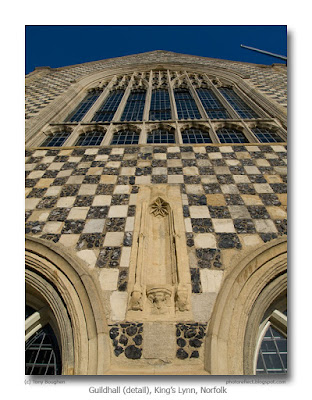 click photos to enlarge
click photos to enlarge The builders of Britain's vernacular buildings created many regional styles. One of the most charming is found in East Anglia, and is known as "flushwork". This involves splitting small pieces of flint so that the black or grey interior is exposed. These are then mortared into patterns which are set in, and contrast with, areas of dressed stone. It is often seen on the medieval churches of Norfolk and Suffolk where letters (often "M" for Mary), quatrefoils, daggers, shields and other designs are built into buttresses, towers, walls and porches.
The builders of Britain's vernacular buildings created many regional styles. One of the most charming is found in East Anglia, and is known as "flushwork". This involves splitting small pieces of flint so that the black or grey interior is exposed. These are then mortared into patterns which are set in, and contrast with, areas of dressed stone. It is often seen on the medieval churches of Norfolk and Suffolk where letters (often "M" for Mary), quatrefoils, daggers, shields and other designs are built into buttresses, towers, walls and porches.The most notable example of flushwork in King's Lynn can be seen in the form of the chequer pattern that covers the walls of the Guildhall, a building of 1422-8. This structure was built for the Guild of Holy Trinity after an earlier hall burnt down. The ground floor of the Guildhall is an undercroft lit by pointed windows under square hoodmoulds. The central pair of arched windows were formerly doorways. Separating them is a slender and delicate vaulted niche that must once have held a statue. The large, panelled-tracery window lights the Stone Hall which forms the whole of the upper floor. In the 1600s the facade with the Doric doorway, circular windows, coat of arms and decorative panel was added.
To the left of the Guildhall is the Town Hall of 1895. Its architects, Tree & Price of London, elected to build with deference to the illustrious neighbour. They continued the chequer pattern and chose a style that mixes free Gothic with Renaissance details. The whole ensemble makes an appealing sight in the sun of an autumn day. Incidentally, the building to the right is the former prison of 1784 with suitably grim decoration (out of shot) modelled on that at Newgate Prison, London.
photographs & text (c) T. Boughen
Photo1 (Photo 2)
Camera: Olympus E510
Mode: Aperture Priority
Focal Length: 11mm (22mm/35mm equiv.):(12mm (24mm/35mm equiv.))
F No: f6.3
Shutter Speed: 1/1000
ISO: 100
Exposure Compensation: -0.7 EV
Image Stabilisation: On